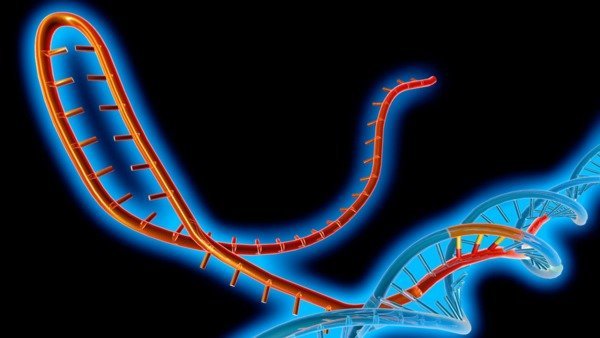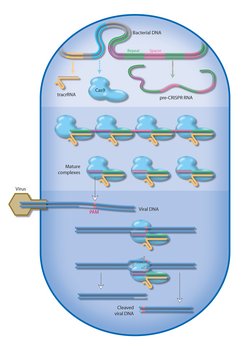
Natural functions of CRISPR-Cas
We humans often identify bacteria as pathogens. But bacteria can also become ill. Some viruses actually have specialized in attacking these tiny microbes. These viruses, which are known as phages, are somewhat reminiscent of space probes that dock at remote planets. They inject their DNA into the bacterial cell, which then reproduces it, thereby creating new phages - a process that can be fatal for the host cell. Like other organisms, bacteria have developed ingenious mechanisms for defending themselves against such invaders. The CRISPR-Cas systems are one such mechanism.
Immune defence with memory

The bacterial cells can use CRISPR-Cas systems to protect themselves from renewed infection, as CRISPR-Cas gives the bacteria’s infection defence a kind of memory: when a phage docks at a bacterial cell and injects its DNA into the cell, a short sequence is inserted between the CRISPR sequences of the bacterial DNA. The variable sections between the CRISPR sequences (spacers) thus constitute a kind of library of all of the pathogens that the bacterial cell has encountered.
The bacterium can also pass this library on to its offspring. Some researchers see this as confirmation of the theory developed by the 19th century French evolution scientist Jean-Baptiste de Lamarck, which was rejected by most scientists for a long time. According to this theory, characteristics acquired over the course of life can be passed on.
Around half of the bacteria known today and almost all species from Archaea have a CRISPR-Cas defence system. The ways in which cells deploy the system can vary from one species to the next. Two CRISPR-Cas classes are known today which can be further subdivided into types and subtypes. The Class 1 systems contain protein complexes consisting of many molecules, whereas the Class 2 systems have only one cutting protein.
What they all have in common is that they insert elements of foreign DNA into the CRISPR region and transcribe RNA molecules from it, which then guide an enzyme or enzyme complex to its target. The RNA molecules can bind to a site on the infiltrated DNA that matches their own sequence and in this way show the Cas enzyme where it should cut the foreign DNA. This renders the viral DNA harmless and wards off infection.
CRISPR-Cas9 is one of the simplest functioning systems and this makes it highly suitable for application in the field of biotechnology. With the CRISPR- and tracrRNA, it needs only two RNA molecules and the Cas9 protein to target foreign DNA and cut it. The two RNA molecules can even be fused in the laboratory to form a single guide RNA molecule, making the system even easier to use. In addition, CRISPR-Cas9 works not only in bacteria but also in cells that have a nucleus. From threadworms to humans - the new gene scissors can operate everywhere.











